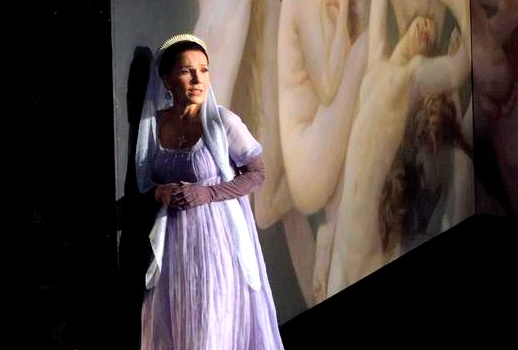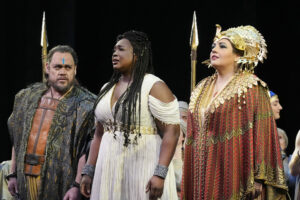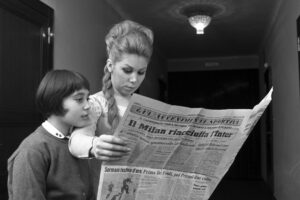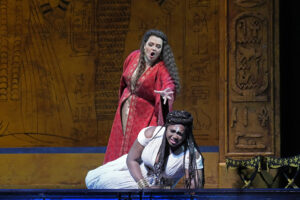

“Cool, Adam… keep moving!”
“You guys have got to see Tosca one day, and you will recognize this site.”
Or not. At least not at Opera Bastille, which is presenting a new production of Puccini’s trusty thriller by Pierre Audi, with three casts of principal singers.
There is no Castel Sant’ Angelo. Nor is there any attempt to recreate the other fabled Roman locations—the church of Sant’Andrea della Valle in the first act and the Palazzo Farnese in the second. What we do have is a giant black and boxy crucifix that dominates the stage. No frills, just chills.
But with musically astute and dramatically committed performances from the principals, chorus, and orchestra alike, why bother kvetching about visual drabness. (At least it fits right in at Bastille, matching its frigid design). Yet Parisians are already getting tired of the production—in particular, the obtrusive crucifix and the military campground that replaces the Castel Sant’ Angelo as Tosca and Cavaradossi’s final encounter.
One positive aspect of Audi’s dark new production—the first in 20 years here—is that he focusses the audience on the characters and their interactions rather than obsessing over time-honoured ‘Tosca details’ that perhaps detract from the modernity and intensity of the piece.
Floria Tosca, sung by French mezzo-soprano (!) Béatrice Uria-Monzon, has some of the best declamatory, semi-shouted lines in all of opera, especially “E avanti a lui tremava tutta Roma!” (All Rome trembled before him), which Uria-Monzon utters with an air of triumphant bewilderment. Uria-Monzon is a commanding stage presence, especially in the third act when she assures her lover that everything has been ‘taken care of’ with Scarpia and that he will be given a “false” execution.
Is it not unusual to have a mezzo-soprano tackle Puccini’s great diva—let alone a mezzo who is singing Didon in Les Troyens and Carmen this season as well? Perhaps, yet the role seems to suit Uria-Monzon well from a vocal standpoint—there is a great deal of impassioned yet measured singing—yet the “money notes” can be strident and the tone unfocused. The shrieking in the second act was quite convincing, but at times she was swallowed up by the orchestra under Israeli maestro Daniel Oren.
Joining Ms. Uria-Monzon was Massimo Giordano (remember him?), who brings much-needed Italianate qualities to this production. Sure, there was plenty of scooping (though thankfully no crooning) and brightness, but the sound is ardent and the high notes ring where they are supposed to. Yet I wished he would throw himself into the music instead of treating it with the exactitude of Mozart. His portrayal is youthful (noticeable in such a dark, brooding production) and—with the exception of an underpowered “Vittoria! Vitoria!” in the second act—vocally satisfying.
But the real highlight of the night belonged to the Scarpia of Romanian baritone Sebastian Catana. Many Scarpias are often described in reviews as “oozing with meanness” but just as many end up barking their way through the short but demanding role. Catana certainly oozes all kinds of bad, but he does it with a delectable flippancy, as if capturing and torturing prisoners like Cavaradossi and assaulting prominent women are simply the components of his daily breakfast.
He does not expend extra energy trying really hard to be a villain. Nor does he park and bark. He parks…and unleashes a voice of significant power and richness. Not beauty, richness. His exaggerated death—including rolling over (he is quite tall, that is from side to side)—suggests he might be studying the role of Falstaff.
Audi’s production boasts some striking moments. In the Te Deum scene in act one, a bevy of priests enter at the top of the crucifix, looking fantastic in Robby Duiveman’s golden costumes. (The first act ends with Scarpia kneeling to the ground, kissing one of the priests’ hands). The chorus and children’s chorus are superb, as per usual here in Paris. Tosca’s death is also well managed, with no gimmicky jumping. Just a blood-red chiffon curtain and some clever lighting, and we have all we need to witness the tragic conclusion to this formidable woman’s life.
In the pit, Maestro Oren clearly knows and loves this opera—I caught him mouthing most of Scarpia’s part—and he seemed to be demanding a lot of the orchestra in terms of dynamic control, and they responded well, only occasionally overpowering the singers.
Later this week, Opera Bastille will welcome three new principals—Oksana Dyka in the title role, Marco Berti as our dear painter, and George Gagnidze (likely) oozing with all that is vile.

























Comments